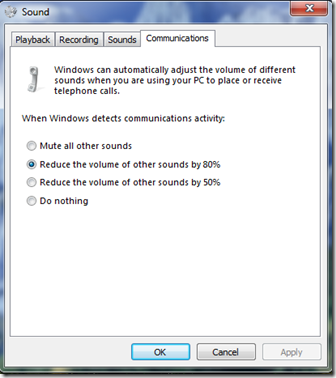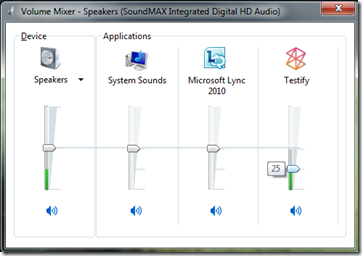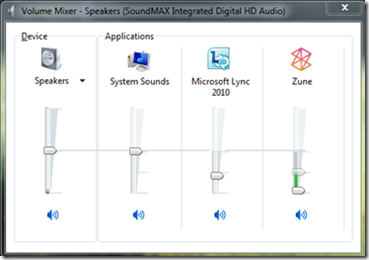Ducking? Music volume experience with incoming Lync call using Zune player
One of our MVP’s, Brian asked a question regarding the experience of volume when using the PC to place or received telephone calls using Lync. The dialog that controls the behavior we are discussing is below and can be reached in a few ways
- Start, Control Panel, Sound, Communications tab
- Right click the speaker icon in the taskbar notifications section and select Sounds, Communications Tab
- In Lync select the gear or cog icon for Options, select Tools - Options, Ringtones and Sounds and the Sound Settings buttons, Communications Tab
Update March 6 2013 - Nikola Howard reached out asking about a group policy setting which I couldn't find but he did. I am still searching for an authoritative Microsoft article and will update this when and if I find that content.
[HKEY_CURRENT_USER\Software\Microsoft\Multimedia\Audio]
"UserDuckingPreference"=dword:00000003
The behavior expected is that I am working and listening to music in Zune and an incoming call notification pops up. I want to take the call but spending the time to reduce the volume of Zune may take longer than I want and possibly miss that call, or I will not be able to adequately hear the remote party over the music.
Update January 20th – Today I received a call from Henry, one of our OCS Certified Masters , and he mentioned that his experience with Windows Media Player differed. I assumed he meant that it worked correctly but turns out his experience, which I reproduced was that Windows Media Player (WMP) actually pauses/stops the media although the WMP UI does not show the pause notification. I continue to follow up but it seems that it may be possible that the client can choose how to implement this feature.
I trust the screen shots illustrate the visual experience of the incoming call, first the screen shot of my volume settings at 50 for speakers, system sounds and Lync, while Zune was set at 25. I will add a note that these values are somewhat relative as I am also able to increase and decrease the volume with the physical laptop controls which do not alter these sliders.
Now when I place a call from my mobile phone to my work number with Lync, notice how the volume control for Lync slides down. One thing I find interesting is not only does the volume slider move down for the Zune player but it also slid down for Lync. I like how the visual experience for the Zune player has the original volume position greyed indicating the change.
Now when the song that was playing during this time ends and the next song is played, the audio increases to the original setting but it does not change the visual shown above. In fact when you slide the controller back to the original position the volume remains at that level instead of adjusting in real-time unless you exceed the original value.
I reached out to our media team for input on the issue and proper logging for investigation. It was a valuable discussion to learn that ducking is a Windows-7 only feature. I am waiting to hear back on what logs to enable for further troubleshooting and will update the post when I receive them.
The feature is designed for when the default communication device is used then Windows reduces the volume level (80% is default value) for all other applications playing media. Ducking should remain in effect if the call is placed on hold and the system will be “unducked” 2 seconds after the call ends allowing the user to hear the call hang up.
MSDN references for ducking or Stream Attenuation:
What’s New for Core Audio APIs in Windows 7
TomlLyncKid
p.s. – For those interested in the non-technical details, music used during testing was P.O.D. Satellite album.


